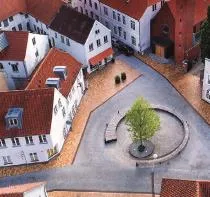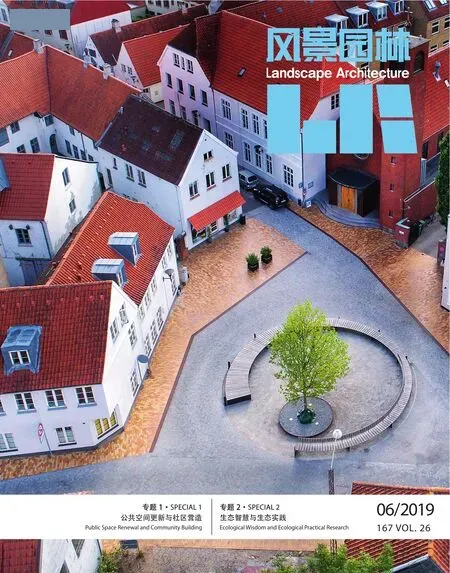公共空间更新与社区营造

作为外部开放空间的公共空间,渗透在人们生活的方方面面,它不仅影响着空间、人和社会的关系,也连接着风景园林、城乡规划设计、建筑设计和社会学等多个领域。随着当前社会经济背景的变化,城市物质环境与社会网络进入了缓慢、谨慎的微更新阶段。不同于以往大拆大建、自上而下的规划设计和建设模式,以公众参与为基础、微小社区空间和公共空间设施为改造对象的局部更新方式,成为激发城市和乡村活力、提升建成公共空间品质的新方式。社区营造在中国尚处于发展阶段,它强调自下而上的参与性,不仅关注社区物质空间层面,同时关注社区居民归属感的培养,通过公众参与实现社区的共建、共治和共享。
因此,在当前城市微更新的背景下,公共空间与社区营造之间建立了比以往更加紧密的联系。公共空间更新不再只是单纯的空间和视觉的设计,更是一种关注人的日常生活、重塑人与人之间交流和邻里关系的途径。公共空间需要具备多重含义:首先,为“日常生活”和“社会生活”提供场所是城市公共空间的基本属性;其次,作为一种具有集聚意义的生活载体,城市公共空间能够将人的各种行为加以关联,同时又具有生态、文化、艺术等多重特征;此外,公共空间应该逐步形成网络,实现秩序化和系统化,从而全方位反映并影响人们的生活。
可见,公共空间和社区营造之间可以起到相互促进、互为补充的作用,通过公共空间微更新能积极有效地推动社区营造,通过社区营造也能够促进公共空间的在地性和长效性。当前的公共空间更新从策划、设计到维护管理,是一个持续渐进的过程,基于社区营造的公共空间微更新途径的核心是公众参与。在物质空间环境建设方面,基于社区营造的城市公共空间微更新强调采用小规模公共空间和社区更新的优越性,反对大规模的城市建设,认为“以小为美”和“有机拼贴”的城市才有活力,宣扬公共空间的渐进式微更新。微更新强调对城市的精细化管理和治理,在以往城市公共空间设计建设过程中,相当多的城市边角空间、碎片空间以及附属空间被忽视以及边缘化。因此,需要在微更新的过程中通过规划设计和相关政策管理对这些空间进行整合和再利用;在公众参与和社区营造方面,基于社区营造的城市公共空间微更新强调社区更新应当注意保护与发展社区文化,通过结合使用者和原住民的日常生活,保障空间物质环境和居民生活的真实性。通过研究社区和社群的结构、关联度和相互之间的组织协作模式,基于社区营造的城市公共空间微更新探讨基于多个利益相关方的社区更新、营建和维护管理,由此提出多元主体参与社区建设与治理的方式。此外,基于社区营造的公共空间微更新还需要将政府部门、居民、企业、社会组织和专业团队放在一个沟通交流的平台上共同促进项目的实施。借此,多个利益方能够表达意愿和诉求,也能调动居民的参与积极性,使其主动全程参与方案的前期分析、具体制定、后期维护管理等多个环节。多元平台的建立有助于综合制定自下而上的长期可持续的微更新计划。
伴随着城市从量化发展步入品质化提升,公共空间微更新更加关注空间重构和社区激活、公众参与和社会治理。公共空间微更新作为一个微小的城市事件,以社区营造为基础,通过边缘空间的整合和触媒方式的选择,促进城市自发性、缓慢而持续的自我完善和提升。通过场地历史文脉原真性的挖掘和社区居民社会生活方式的保护,促使城市原真性的保留;通过建立多方协作的开放沟通平台、实现基于公众参与的全程社区营造,促进城市社区的共建和共治。
本期专题文章分别从国内外案例研究、社会聚集与空间形态研究、社区花园的公共空间营造实践、胡同绿色微更新实践等多个角度探讨基于社区营造的公共空间设计和提升途径。试图理论结合实践,从多个角度深入剖析社区营造用于公共空间设计的合理途径。由于这些研究和实践分布于不同的地区,我们也希望通过本期专题讨论,能够形成一种该领域的学术和实践对话,从而通过不同视角和不同地域的探讨,引发各界的思考和进一步探索,促进公共空间和社区营造领域的进一步发展。
本期专题组稿人:侯晓蕾
2019年5月11日
PREFACE
Public Space Renewal and Community Building
Public space, as open exterior space, can be seen in all the aspects of people’s life. It affects the relationship among the space, human and the society as well as relates to many fields such as landscape architecture, urban and rural planning, architecture and sociology etc. As the social and economic context changes recently, urban physical environments and social network have stepped into a slow and prudent phase of micro-renewal. Different from the largescale and the top-down mode of planning and construction in the past, the partial renewal based on public participation and taking small community spaces and public space facilities as the objects has become a new mode applied to stimulating the vigor of urban and rural area and promoting the quality of public spaces. Community building in China is still in the development phase. It attaches importance to top-down participation, pays attention not only to the physical space of communities but also the cultivation of the belongingness of community residents and strives to realize the coconstruction, co-governance and sharing of communities through public participation.
Therefore, in the current context of micro renewal of cities, a closer relationship has been established between the public space and community building. The renewal of public space is no longer just the space and visual design but also an approach with which people’s daily life can be concerned and neighborly relations can be reshaped.Multiple meanings should be given to the public space: Firstly, it is the basic property to provide places for people’s daily routine and social life. Secondly, as a carrier of life with the significance of gathering, it should correlate various of people’s behavior and should have multiple characteristics such as ecology, culture, art, etc. In addition, public spaces should gradually form a network to realize regularization and systematization so that it could affect people’s life in an all-round way.
So that public spaces and community building complement and promote each other. Micro renewal of public spaces plays an active role in promoting community building, on the other side, community building promotes the locality and long-term effectiveness of public spaces. At present, the renewal of public spaces in terms of planning,design and maintenance management is a continued and gradual process. Public participation should be the core of the new approach for public space micro renewal based on community building. In terms of environment construction of physical spaces, the micro renewal of urban public spaces based on community building emphasizes the use of the superiority of small-scale renewal of public spaces and communities, meanwhile opposes large-scale urban construction. It is believed that cities adhering to the philosophy of“regarding small scale as beauty” and “organic combination” will be vigorous, which advocates progressive micro renewal of public spaces. In urban micro renewal, delicate management and governance of cities are emphasized. In the previous urban public space design and construction process, quite an amount of corner spaces,fragmented spaces and auxiliary spaces in cities were neglected and marginalized. Therefore, these spaces need to be integrated and reused in the micro renewal process by the planning and design as well as management based on relevant policies. In terms of public participation and community building, micro renewal of urban public space based on community building emphasizes that the protection and development of community culture should be noted in the process of community renewal, and the reality of the physical environment and residents’ life should be guaranteed by virtue of the combing the daily routine of space users and indigenous residents.Through studies on the structure, the degree of correlation and the cooperative mode of communities and community clusters, micro renewal of urban public space based on community creation needs a discussion about community renewal, construction and maintenance management by taking into account of several stakeholders to put forward the mode of community construction and governance with multiple subjects involved. What’s more, micro renewal of public space based on community building also needs a platform for the communication of the government, residents, enterprises,social organizations and professional teams to promote the implementation of projects jointly. By such a platform, stakeholders can express their willingness and appeals and residents’ enthusiasm for participation can be aroused to make them take an active part in multiple links, such as context analysis, specific envolvment and further maintenance and management. The establishment of a multiplatform helps comprehensive preparation of down-top long-term sustainable micro renewal proposals.
Along with the transformation of cities from quantitative development to qualitative improvement, more importance is attached to the spatial restructuring, community revitalization, public participation and social governance in the micro update process of public spaces. As a tiny event in cities, public space micro renewal based on community creation can promote spontaneous, slow and sustainable self-improvement of cities by the integration of marginalized spaces and catalysts. The authenticity of cities can be reserved by exploring the authenticity of local historical contexts and protecting the lifestyle of community residents. The co-construction and co-governance of urban communities can be promoted by the community building based on whole-process participation of the public and the establishment of an open communication platform based on collaboration of multiple parties.
In topic articles of this issue, design and improvement method of public spaces based on community building are discussed from various perspectives, including case studies home and abroad, studies of social gathering and spatial forms, practices of public space creation of community garden, green micro renewal practice in Hutongs, etc.It tries to combine theories with practices to deeply analyze reasonable approaches of applying community building in public space design from different aspects. Since these studies and practices distribute in different regions, we hope that an academic and practical dialogue can be formed in this field through topic discussion of this issue so as to arouse thinking of all walks of life and further exploration to promote further development of the field of public space and community building.
Translator: WANG Xiyue
Acquiring editor of the current issue: HOU Xiaolei
May 11th, 2019

